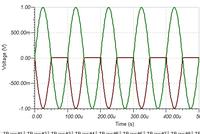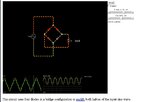Yair Malka
Newbie level 2
Hey, I'm new here.
My English is't good enough so I apologize about the Grammer mistakes.
I have some mini-work to do about the Full wave rectifier.
The work is to explain the behaviour of the circuit.
The circuit looks like that:

I just want to know how does the circuit work?
maybe more important how does the 1st amplifier works?
I ran a simulation in Tina (software) and got this behaviour for the first stage:

If i will know how the first stage works, and why in the positive wave input I get a negative wave at the output,
and when the input is negative I get zero at the output, I will understand properly how the circuit works because I know how the second stage works.
I will really glad to know how it works and especially the first stage (with the two diodes).
Thank you very much, and sory about the English again.
My English is't good enough so I apologize about the Grammer mistakes.
I have some mini-work to do about the Full wave rectifier.
The work is to explain the behaviour of the circuit.
The circuit looks like that:

I just want to know how does the circuit work?
maybe more important how does the 1st amplifier works?
I ran a simulation in Tina (software) and got this behaviour for the first stage:

If i will know how the first stage works, and why in the positive wave input I get a negative wave at the output,
and when the input is negative I get zero at the output, I will understand properly how the circuit works because I know how the second stage works.
I will really glad to know how it works and especially the first stage (with the two diodes).
Thank you very much, and sory about the English again.
